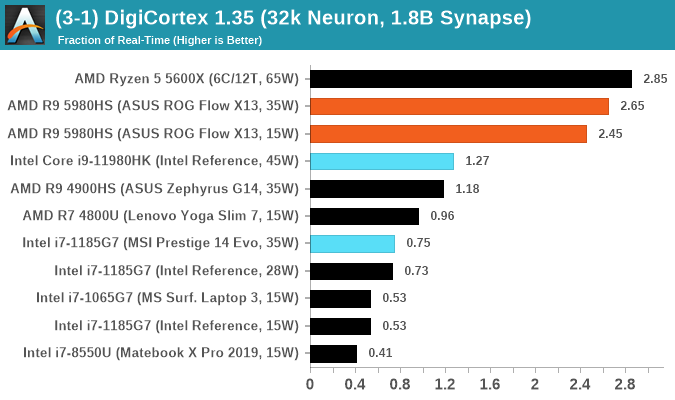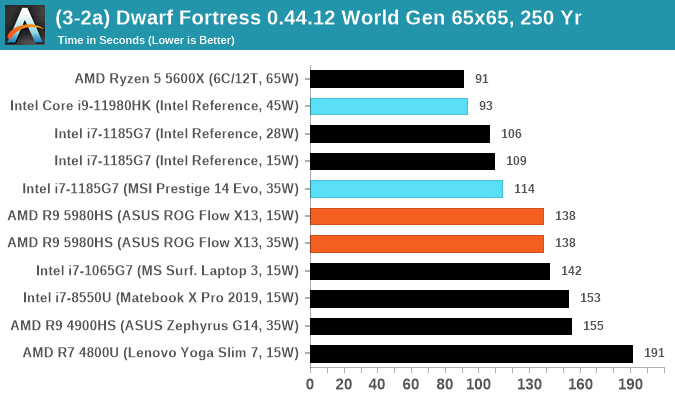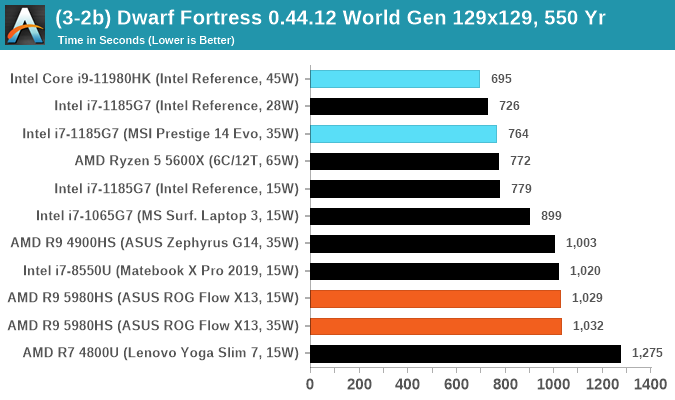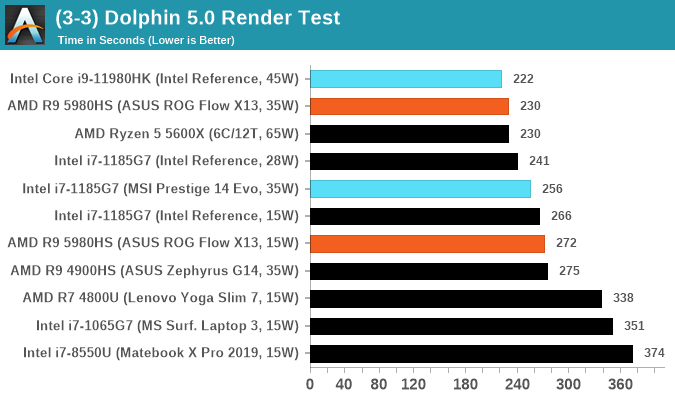Intel 11th Generation Core Tiger Lake-H Performance Review: Fast and Power Hungry
by Brett Howse & Andrei Frumusanu on May 17, 2021 9:00 AM EST- Posted in
- CPUs
- Intel
- 10nm
- Willow Cove
- SuperFin
- 11th Gen
- Tiger Lake-H
CPU Tests: Simulation
Simulation and Science have a lot of overlap in the benchmarking world, however for this distinction we’re separating into two segments mostly based on the utility of the resulting data. The benchmarks that fall under Science have a distinct use for the data they output – in our Simulation section, these act more like synthetics but at some level are still trying to simulate a given environment.
DigiCortex v1.35: link
DigiCortex is a pet project for the visualization of neuron and synapse activity in the brain. The software comes with a variety of benchmark modes, and we take the small benchmark which runs a 32k neuron/1.8B synapse simulation, similar to a small slug.
The results on the output are given as a fraction of whether the system can simulate in real-time, so anything above a value of one is suitable for real-time work. The benchmark offers a 'no firing synapse' mode, which in essence detects DRAM and bus speed, however we take the firing mode which adds CPU work with every firing.
The software originally shipped with a benchmark that recorded the first few cycles and output a result. So while fast multi-threaded processors this made the benchmark last less than a few seconds, slow dual-core processors could be running for almost an hour. There is also the issue of DigiCortex starting with a base neuron/synapse map in ‘off mode’, giving a high result in the first few cycles as none of the nodes are currently active. We found that the performance settles down into a steady state after a while (when the model is actively in use), so we asked the author to allow for a ‘warm-up’ phase and for the benchmark to be the average over a second sample time.
For our test, we give the benchmark 20000 cycles to warm up and then take the data over the next 10000 cycles seconds for the test – on a modern processor this takes 30 seconds and 150 seconds respectively. This is then repeated a minimum of 10 times, with the first three results rejected. Results are shown as a multiple of real-time calculation.

Dwarf Fortress 0.44.12: Link
Another long standing request for our benchmark suite has been Dwarf Fortress, a popular management/roguelike indie video game, first launched in 2006 and still being regularly updated today, aiming for a Steam launch sometime in the future.
Emulating the ASCII interfaces of old, this title is a rather complex beast, which can generate environments subject to millennia of rule, famous faces, peasants, and key historical figures and events. The further you get into the game, depending on the size of the world, the slower it becomes as it has to simulate more famous people, more world events, and the natural way that humanoid creatures take over an environment. Like some kind of virus.
For our test we’re using DFMark. DFMark is a benchmark built by vorsgren on the Bay12Forums that gives two different modes built on DFHack: world generation and embark. These tests can be configured, but range anywhere from 3 minutes to several hours. After analyzing the test, we ended up going for three different world generation sizes:
- Small, a 65x65 world with 250 years, 10 civilizations and 4 megabeasts
- Medium, a 127x127 world with 550 years, 10 civilizations and 4 megabeasts
- Large, a 257x257 world with 550 years, 40 civilizations and 10 megabeasts
DFMark outputs the time to run any given test, so this is what we use for the output. We loop the small test for as many times possible in 10 minutes, the medium test for as many times in 30 minutes, and the large test for as many times in an hour.


Dolphin v5.0 Emulation: Link
Many emulators are often bound by single thread CPU performance, and general reports tended to suggest that Haswell provided a significant boost to emulator performance. This benchmark runs a Wii program that ray traces a complex 3D scene inside the Dolphin Wii emulator. Performance on this benchmark is a good proxy of the speed of Dolphin CPU emulation, which is an intensive single core task using most aspects of a CPU. Results are given in seconds, where the Wii itself scores 1051 seconds.













229 Comments
View All Comments
back2future - Tuesday, May 18, 2021 - link
it's almost one could skip PCIe4 if early 2022 PCIe5 is stable on power management and performance expectations on mainboards?mode_13h - Thursday, May 20, 2021 - link
> it's almost one could skip PCIe4 if early 2022 PCIe5 is stable ... on mainboards?Uh, I'm still eager to see exactly how Intel is going to use PCIe 5, in Alder Lake. I suspect it'll be used only for the DMI link to the chipset, in fact.
Since graphics cards and M.2 SSDs aren't even close to maxing PCIe 4, I struggle to see why they would bother with the added cost and potential issues of supporting 5.
heickelrrx - Monday, May 17, 2021 - link
you can put 4x link on Video card and get 8x speed on Gen 3mean they can put more stuff, with less link, not faster stuff
mode_13h - Tuesday, May 18, 2021 - link
> you can put 4x link on Video card and get 8x speed on Gen 3In terms of power-efficiency, I'd bet the wider, slower link is better.
> mean they can put more stuff, with less link, not faster stuff
It's a laptop. So, prolly not gonna run out of PCIe lanes.
gagegfg - Monday, May 17, 2021 - link
"and if anticipated, great gaming performance"...Inside this notebook case he had a hard time controlling the temperature, if you add a 100W GPU, where is the rest for this cpu?
mmm .... it's going to be interesting.
Matthias B V - Monday, May 17, 2021 - link
Most OEMs still prefer Intel as it has capacity that AMD can't offer and even more it has better features and integration such as AV1 coding, USB / TB 4.0, Intel WIFI etc.Also Intels provides better support for OEMs in design and issues.
Gigaplex - Monday, May 17, 2021 - link
AMD systems can provide TB support, there's no technical limitation preventing it. Intel WiFi chips are standalone cards, which also work fine in AMD systems (my AMD board has Intel WiFi). There's no reason to use an Intel CPU for either of those features.Retycint - Monday, May 17, 2021 - link
The fact that not a single AMD laptop has thunderbolt, points to an issue with cost of implementation/PCI lanes limitations etc. which apparently doesn't exist on Intel CPUs, given how many Intel laptops come with TB as default. This is a fact, and talking about what's possible theoretically doesn't change the facts that AMD systems lack TBCityBlue - Monday, May 17, 2021 - link
> The fact that not a single AMD laptop has thunderbolt, points to an issue with cost of implementation/PCI lanes limitations etc.Perhaps. Or it's simply a reflection of the fact that there is only niche demand for TB.
It's on Intel based laptops because it's supported by the chipset so pretty much a no-brainer (or alternatively, Intel mandates it is included, in order to try and make it more relevant?)
However the vast majority of laptop consumers don't need, want or care about TB, so the extra cost to include it in AMD laptops doesn't appear justified. I'm sure a vendor could include TB on an AMD laptop if they ever thought they'd get a reasonable return on the extra cost.
And maybe now that Intel have been kicked in to touch by Apple, Intel might lose interest in TB in future.
TB has its fans, but it also has the distinct whiff of being the next FireWire.
RobJoy - Tuesday, May 18, 2021 - link
The fact that TB still exists, baffles me.We all should move on.